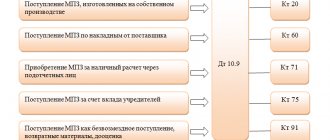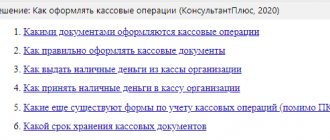Writing off office supplies and documenting them in accounting is an important process, because it is difficult to imagine an organization that has no writing materials at all. Any contact with a client, especially personal, involves signing papers, printing contracts and binding sheets together. Warehouse operations also involve a lot of paperwork. It’s hard to imagine an office without pens, or any office without a seal. But every item fails and ends at some point.
What can be classified as office supplies?
This usually includes all devices that are intended for writing, designing and printing documentation.
Among the main copies:
- pens and pencils;
- felt-tip pens, markers, highlighters;
- paper, white and colored;
- cardboard;
- notebooks, notepads.
Separately, it is worth considering the fastening parts:
- paper clips, staples;
- glue;
- folders, cases, binders.
It is difficult to imagine an enterprise without devices. Among organizational and mechanical equipment:
- typewriters;
- calculators;
- scanner;
- hole puncher;
- stapler
Also, we must not forget about the cabinets in which all this will be stored, about school bags and other types of products that can be attributed to this.
This category contains promotional products that are issued to employees for distribution and use. Everything that is on the balance sheet and has actually already been spent should be written off.
Reasons and grounds for writing off material assets
This group is characterized by its unpredictability - it is impossible to predict a fire or the moment when a manufacturing defect occurs. Therefore, financially responsible persons and accounting specialists are faced with the task of timely writing off material assets that have become unusable from accounting accounts. The continuity of the technological process depends on the speed of purchasing new batches of materials, and timely documented write-offs increase the reliability of information in reporting (about the cost of enterprise property and technological losses). In the first case, for the write-off of each batch of raw materials and materials, there is no need for a special written permission from management - the write-off is carried out according to established standards, which must be justified and approved by the head of the enterprise. The write-off process has its own characteristics, which will be discussed in one of the subsequent sections.
Please note => For low-income families in the Perm Territory
Write-off act for office supplies
If the office was purchased with the company's money, then over time it is necessary to write it off in order to buy a new one. The main thing is to fill out this document correctly and comply with all the standards established by the company. Completing this paper is a mandatory part of the procedure; it is a primary accounting form.
Who has the right to use
This is a common form of deregistration, which is actively used by small, medium and large businesses alike, since every enterprise needs to write off office supplies. The tax system does not play a role here.
Why register it?
Quite often, companies that regularly purchase “stationery” classify it as an expense at the time they purchase it. But this is the wrong decision, because the tax service may issue a fine, since in this case the income tax becomes higher. The inspector does not recognize this as expenses that relate to the main activity for no reason.
It is the drawn up document that becomes the reason that justifies the removal of inventory items from the register and allows the amount to be added to the expenses of the enterprise. With its help, it becomes possible to officially reduce the tax base for all expenses of this kind.
Reasons and grounds for writing off office supplies in the act - sample and examples
Many accountants believe that it is easier to carry out such an operation immediately after purchasing a CT scanner. That is, they are brought to the company, the production is noted and immediately attributed to the expenses of the main activity. On the one hand, this way the specialist does not forget to indicate the expenses. But on the other hand, periodic acquisition and constant withdrawal on the same day becomes a violation.
When the inspector conducts an audit of activities, he will recognize this method as incorrect, recalculate and redistribute the balance so that a large amount will have to be paid due to changes in the level of profit.
Therefore, it is worth acting differently. How to write off an office - remove materials according to a pre-planned schedule, which will be established by special order. Another option is to create a manager’s order, in accordance with which responsible persons carry out an inventory.
At what point is it compiled and who will apply it?
This procedure assumes that records were kept from the acquisition of materials to removal from the balance sheet of the enterprise. Therefore, all operations must take place and it is necessary that they follow a certain algorithm.
How this is done:
1. Inventory and materials are received from a supplier or a traveling employee - written by PKO according to f. No. 4;
2. If it is necessary to send goods to a specific department, then indicate the requirement-invoice (form No. 11), which contains the purpose and quantity of products;
3. A document is drawn up and signed, preceded by a management order.
Each enterprise can use such paper for general taxation and for “simplified” taxes. That is, they can remove items from the balance that they previously placed there. But it is important that the CT scans are in a volume that is greater than what is written off. At the time of inventory before drawing up the act, they must also be on the accounts.
It is not advisable to leave all this to chance, since if you do not control the quantities and do not receive inventory items upon receipt, then problems will appear later at the time of write-off, since there is no reason for this. Even if it seems that the cost of the purchased pens is small, it gradually accumulates and it will no longer be possible to remove it from the balance with one operation. The shortages will grow every month. However, reporting will not be possible.
Now there are many different orders and recommendations from the Government that relate to the deregistration of fixed assets and inventory items. Note that it reveals two applications:
1. Reflects the status of the accounts on which the calculation will be carried out;
2. Shows how the budget tool can be used.
In addition, each organization must draw up its own internal regulations, which help regulate the features and order of movement of CT.
Legislative acts on the topic
It is recommended to study the following documents:
| Document | Name |
| clause 93 of the Guidelines for accounting for inventories | On the write-off of office supplies upon transfer to employees based on the invoice requirement in form No. M-11 |
| clause 13.3 PBU 5/01, Information message of the Ministry of Finance dated June 24, 2016 No. IS-accounting | On the write-off of office supplies as expenses for ordinary activities at the time of purchase without accounting entries (with simplified accounting) |
| paragraph 73 of the Guidelines | On consolidating the chosen method of writing off office supplies in the company’s accounting policy |
Ready-made solutions for all areas
Stores
Mobility, accuracy and speed of counting goods on the sales floor and in the warehouse will allow you not to lose days of sales during inventory and when receiving goods.
To learn more
Warehouses
Speed up your warehouse employees' work with mobile automation. Eliminate errors in receiving, shipping, inventory and movement of goods forever.
To learn more
Marking
Mandatory labeling of goods is an opportunity for each organization to 100% exclude the acceptance of counterfeit goods into its warehouse and track the supply chain from the manufacturer.
To learn more
E-commerce
Speed, accuracy of acceptance and shipment of goods in the warehouse is the cornerstone in the E-commerce business. Start using modern, more efficient mobile tools.
To learn more
Institutions
Increase the accuracy of accounting for the organization’s property, the level of control over the safety and movement of each item. Mobile accounting will reduce the likelihood of theft and natural losses.
To learn more
Production
Increase the efficiency of your manufacturing enterprise by introducing mobile automation for inventory accounting.
To learn more
RFID
The first ready-made solution in Russia for tracking goods using RFID tags at each stage of the supply chain.
To learn more
EGAIS
Eliminate errors in comparing and reading excise duty stamps for alcoholic beverages using mobile accounting tools.
To learn more
Certification for partners
Obtaining certified Cleverence partner status will allow your company to reach a new level of problem solving at your clients’ enterprises.
To learn more
Inventory
Use modern mobile tools to carry out product inventory. Increase the speed and accuracy of your business process.
To learn more
Mobile automation
Use modern mobile tools to account for goods and fixed assets in your enterprise. Completely abandon accounting “on paper”.
Learn more Show all automation solutions
Write-off and recycling of computer equipment
Technology contains a large amount of substances harmful to health . For these reasons, low-cost enterprises should properly plan their budget and take into account the recycling of computer equipment. An organization that has permits for this type of activity will provide assistance in this regard. The recycling procedure is mandatory for all organizations, firms and institutions. This includes the processing of raw materials and the manufacture of other materials, reusing and changing their structure. The fact is that the spare parts that make up computers take decades to decompose: they contain microcircuits containing precious metals. It should be remembered that violation of recycling standards falls under Article 19.14 of the Code of Administrative Offenses, and the perpetrators will be subject to penalties in the amount of up to 30,000 rubles .
How to write off office supplies: documentation in a budget institution
It is important here to check what is deregistered and in what quantity, because the tax office will definitely raise questions about 10 calculators every month, which are used by a department of 2 people.
More often, small CTs are purchased for cash or by bank transfer; in the first case, this is usually purchased by an accountable person; in the second, it is transferred to a bank account in favor of the supplier.
It doesn’t matter whether they will be transferred to the warehouse or immediately used by employees, they should be recorded in accounting. For this procedure, a specialist will need:
- invoice;
- cash and sales receipts.
Based on the first document, the accountant will draw up a PQR, which will indicate the names of all CTs that were purchased. Units of measurement and quantities of purchased items are also specified. Enter the financially responsible person who made the purchase and the one to whose warehouse the goods are credited.
The header of the statement will look like this:
| № | Employee's full name | Unit change | Volume | Signature |
It is filled out by the MOL when it is issued from warehouses to people for use. At the end of the month, he closes it, checks actual availability with virtual balances, and transfers it to the accounting department. These papers may be closed at another period if this is established by internal regulations.
Based on this file, the accountant draws up a demand invoice for writing off office supplies. It reflects the general CT issued and is filed with the rest of the documents of the month.
It is worth remembering that if the organization is small and there are not many employees who use CT, then the statement is not required. When the office movement is small, you can immediately use the demand invoice and write off on this basis. In addition, an act is drawn up.
The manager checks the completion and number of specified copies of the CT, looks at the availability of documentation in accounting. If everything is correct, then the costs are included in expenses and are considered written off.
Receipt of office supplies: accounting entries
Like other materials, office supplies will be accounted for in account 10, and the subaccount is chosen at the discretion of the accountant. Read also the article: → “Accounting for account 10: postings, examples. Receipt and write-off of materials." The choice of Credit depends on the method of purchase:
| Purchasing through a supplier | Purchase by reporting employee |
| D 10 K 60 | D 10 K 71 |
Written-off stationery - documentation in the Republic of Belarus (budget discrepancies)
To carry out this operation correctly, you need to enter the following information:
- name of the insurance company;
- the date on which the products were shipped;
- the number of the telephone message indicating that the sender was called, and the date on which it was composed;
- volume of seats;
- what does the packaging look like?
- units in which the measurement is carried out;
- passport ID.
It is worth noting that the contract can specify other papers that will be drawn up if deviations are detected.
Postings for office supplies in 1C
- “Pass” button ;
- Button “Result of document posting”.
Rice. 135
Please rate this article:
Registered users have access to more than 300 video lessons on working in 1C: Accounting 8, 1C: ZUP
Registered users have access to more than 300 video lessons on working in 1C: Accounting 8, 1C: ZUP
I am already registered
After registering, you will receive a link to the specified address to watch more than 300 video lessons on working in 1C: Accounting 8, 1C: ZUP 8 (free)
By submitting this form, you agree to the Privacy Policy and consent to the processing of personal data
Login to your account
Forgot your password?
What wiring should be
First you need to determine where the materials could go. There are many such paths in every organization; there is always the opportunity to write them off somewhere:
- as a basis for production;
- will become packaging for GP;
- one of the auxiliary consumables for the manufacture of the final product;
- promotes the liquidation of out-of-service fixed assets;
- used by the administration in their activities;
- useful for OS construction.
Depending on what a certain number of handles or cabinets were used for, the wiring data changes:
- Dt 20 – Kt 10 – when raw materials are sent to the production workshop;
- Dt 25 – Kt 10 – materials transferred to the repair department;
- Dt 26 – Dt 10 – the accounting department received office paper;
- Dt 44 – Kt 10 – containers for GP were issued;
- Dt 91-2 – Kt 10 – office supplies are allocated for the liquidation of a certain fixed asset;
- Dt 94 – Kt 10 – the missing (shortage) CTs were written off.
To which account should stationery be attributed and how to take it into account?
The main one is 10, called “Materials”. Their appearance should be recorded as a debit on subaccount 10.09, but there are other options.
Regardless of the type of payment, the transactions should be entered in the following form:
| Procedures | Dt | CT | According to what |
| Office costs are paid | 60 | 51 | Documentation from the bank is attached |
| Everything is moved to storage areas | 10.09 | 60 | PKO f. M-4 or invoice from the supplier signed by MOL |
| VAT on the purchase of office supplies | 19 | 60 | SF from the supplying organization |
| Accounting for incoming VAT | 68 | 19 | |
| Processed by JSC | 60 | 71 | Advance documentation |
| Credited to CT | 10 | 60 | F. M-4 |
| Input VAT | 19 | 60 | Papers that confirm arrival |
| VAT included | 68 | 19 | A receipt showing VAT separately |
To which subaccount should I assign stationery and how to capitalize them later?
Organizations operate in two different ways:
- each item indicating price and quantity;
- a homogeneous group is isolated; as an example, different folders or writing instruments can be cited.
It is worth remembering that method 1 is more reliable; tax authorities have no questions about it. It is easy to use if you purchase a lot of office supplies, but it is sent to employees gradually, in small portions. Another advantage of the method is that you can calculate the need to ensure a normal workflow.
The main entries will be associated with accounts Dt 10 and Kt 60 and 71. There is no big difference in which sub-account everything is credited to, the main thing is to reflect your desire to conduct business in a certain way in the UP.
We count the entire receipt as one piece
If this option was chosen, then everything is credited as 1 unit and will be written off the same way. To use this method, you need to issue an order, on its basis the office will be accepted and immediately left for needs.
In this case, the PKO is attached to a copy of the delivery note from the supplier, this will allow the receipt to be tracked if necessary.
To deregister, employees’ applications are attached to an invoice or other similar document.
Among the advantages is ease of use. But this method can provoke a lot of questions from the tax inspectorate.
Acceptance by quantity
This is another option that is not used as often. Here only the purchased volume will be counted, without names or forms. It will look like “Stationery, 15 pcs.” This is convenient, but can create issues due to the large difference in cost. For example, disposing of one chair will cost many times more than a ballpoint pen.
How to keep records without counting 10
In practice, sometimes accounting is carried out without “Materials”. Typically, this method is chosen when it is planned to immediately use CT for the needs of the company. And these expenses can be recorded as services as expenses. All this is recorded in accounting entries, where Dt is 25-26 and 44, and Kt is considered as 60 and 71.
If only small amounts are used in this algorithm, then the tax authorities will not have any questions. But if a lot of money is regularly spent on this and the article is often repeated, then such an error will provoke the interest of inspectors.
Difficulties may also arise if it is necessary to deduct the amount of input VAT, because the purchase was not accepted for accounting according to the rules.
Another difficulty is trying to track what exactly was spent and in which workshop or department. When checking, it will be very difficult to understand which employees are ordering too much, and which departments are purchasing too much and is costly and unjustified.
What are the stages of purchasing office supplies?
The whole procedure consists of several sequential steps:
- First, a product is purchased, and a cash receipt and sales receipt must be obtained.
- A PKO is drawn up, without which it will not be possible to capitalize the “stationery”.
- Then the purchased items are sent to the warehouse or, in some cases, directly to the requesting department. If the actions were carried out through a warehouse, then a standard form is first drawn up. No. 4, then everything is issued upon request - an invoice with a mandatory mark in the statement.
- The last action of the life of the CT on the territory of the company will be the act of writing off and attributing it to the expenses of the enterprise. Remember that the document can be compiled in free form, this is not a unified paper. But it is better if a template is drawn up within the company according to which everything will happen every time.
We looked at how to correctly write off office supplies so as not to raise questions from the tax authorities and to correctly keep records of all purchased CTs in the organization.
This is necessary to avoid unnecessary losses and costs, because even if it seems that the amount spent on office supplies is minimal, it still needs to be taken into account. Gradually, it accumulates and turns out to be a serious expense item, so we advise you to keep an eye on it. Number of impressions: 39142
Rules for drawing up a document
There is no single unified, mandatory sample of a write-off act. Businesses and organizations can choose one of two options:
- every time, if necessary, draw up an act in free form (which is not entirely convenient),
- develop a document template yourself and based on your needs (in this case, it must be approved in the company’s accounting policies).
At the same time, regardless of which method of drawing up the act form for writing off office supplies is chosen, you must adhere to certain standards in filling it out. In particular, it must indicate
- date of compilation,
- name of the company that purchases the office supplies,
- a complete list of write-off goods (indicating quantity and price),
- signatures of the chief accountant and the head of the enterprise.
You should be very careful when filling out the form, you should avoid mistakes, and especially not enter unreliable or deliberately false information into the document, which could lead to punishment from regulatory authorities.
Breakdown of the write-off formulation calculator
Well, there’s something like “the motherboard is faulty,” “the central processor,” “the math coprocessor.” Here it is important to know 3 things: 1) how qualified are those who will read this; 2) how interested/not interested they are in writing off; 3) whether they will check whether what is written corresponds to reality. BTW, don’t forget to remove everything useful from your computer, including floppy drives, connecting cables and cables






